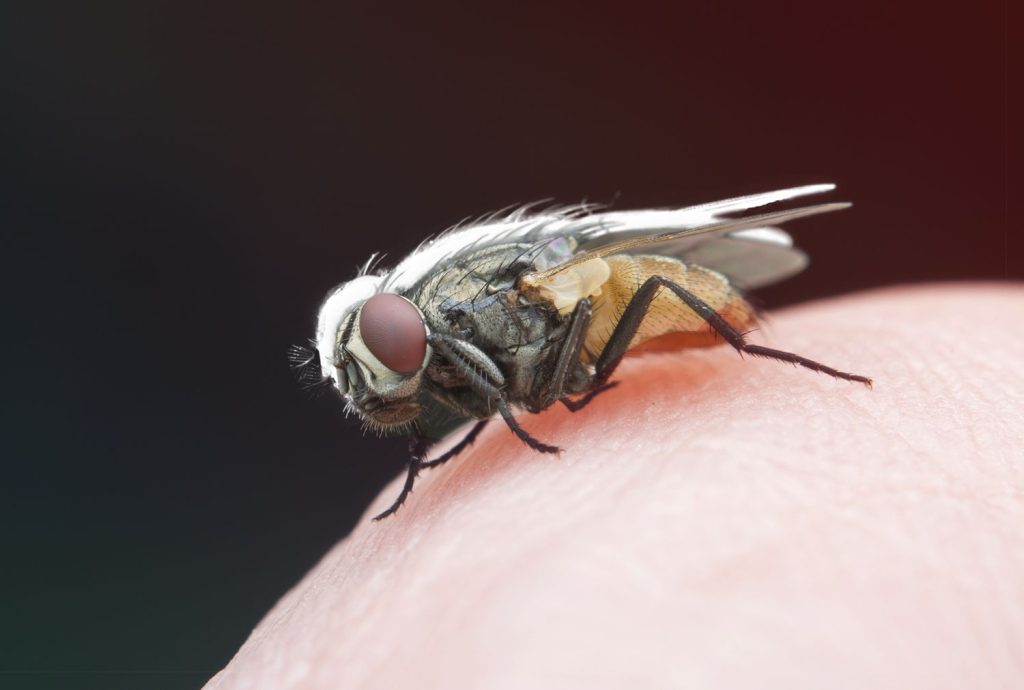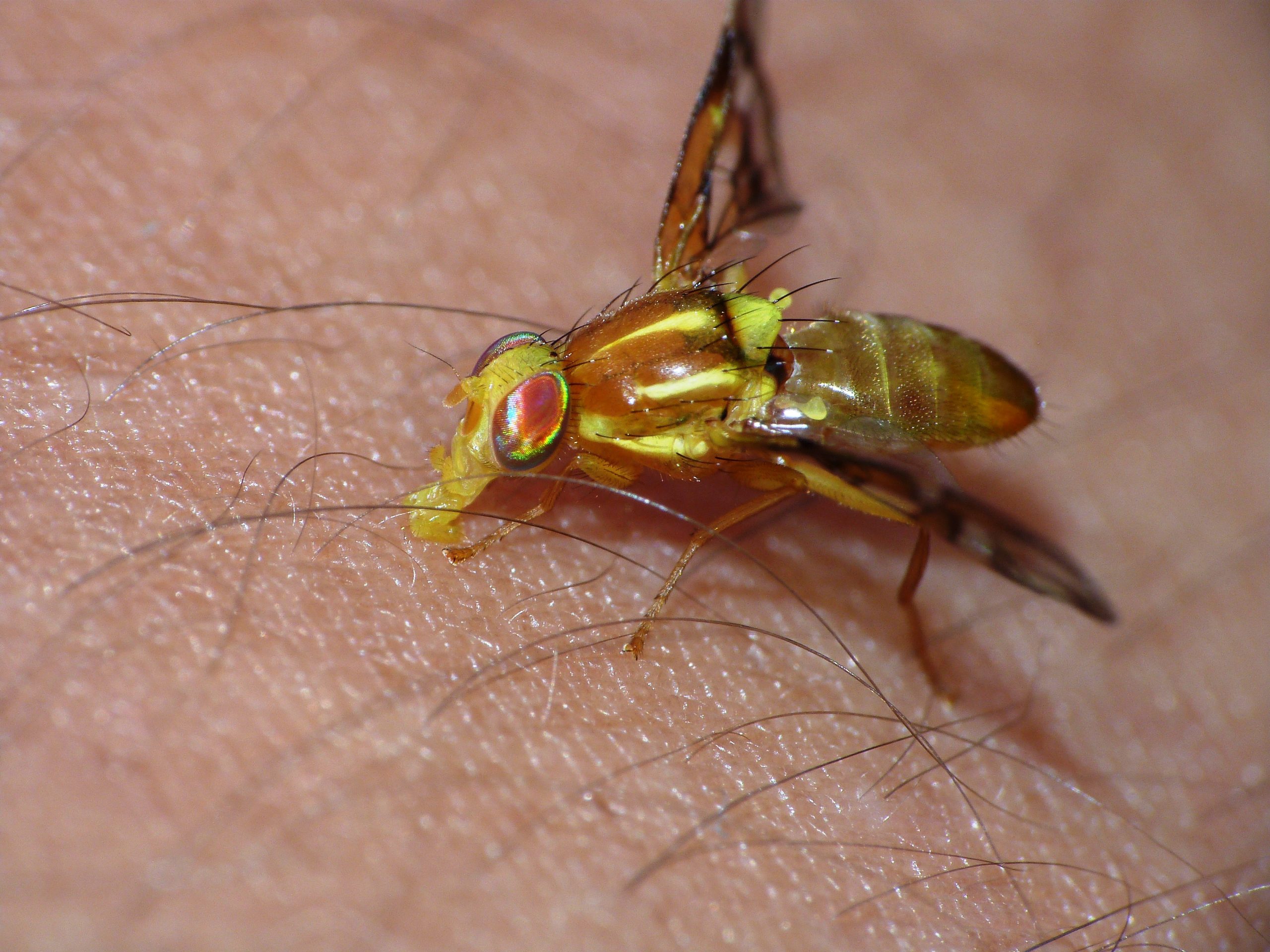Most common house flies, which are often seen in and around homes, do not bite humans. They have mouthparts designed for sponging and lapping, primarily feeding on decaying organic matter, garbage, and other non-human food sources.
House flies are more likely to land on humans, but they do not bite in the same way that mosquitoes or other blood-feeding insects do.
However, some types of flies can bite or sting humans. For example:
- Horseflies and Deer Flies: These big, biting flies have mouthparts like scissors that can cut your skin to drink blood. Their bites hurt and can make your skin swell and feel uncomfortable.
- Sandflies: Tiny sandflies in some areas can pass on diseases like Leishmaniasis when they bite you.
- Black Flies: Black flies, also known as buffalo gnats, can bite humans and other animals, leaving itchy welts.
- Stable Flies: These flies have a painful bite and often target the lower legs and ankles of humans.
Why Biting Flies Bite and What They Feed On?

Biting flies have evolved to feed on blood as a source of nutrition. Both stable flies and horse flies have specialized mouthparts adapted for piercing the skin and accessing blood vessels.
They are attracted to the warmth, exhaled carbon dioxide, and certain chemicals emitted by their hosts, which can include humans.
These flies require a blood meal for their reproduction. Female biting flies need the proteins found in blood to develop their eggs.
After feeding on blood, they will lay their eggs in suitable breeding sites, such as decaying organic matter or water sources.
Consequences of Fly Bites for Humans
Discomfort: Biting flies can cause significant discomfort to humans. Their bites are often painful and can result in itching, swelling, and skin irritation. The sensation of a horsefly or stable fly bite is quite different from that of a mosquito bite and is generally more painful.
Potential Disease Transmission: While the primary concern with biting flies is their painful bites, some species can also transmit diseases. For example, sandflies are known vectors of diseases like Leishmaniasis.
Bites from infected sand flies can lead to the transmission of this parasitic disease, which affects both humans and animals.
It’s important to note that not all biting flies are vectors of diseases, but their bites can create open wounds that may be susceptible to secondary infections.
No-Biting Flies
Common Non-Biting Fly Species
House Flies (Musca domestica): House flies are one of the most common non-biting fly species found in and around human habitats. They have a grayish appearance with four dark stripes on their thorax.
House flies do not bite humans but can be a nuisance as they frequently land on food, surfaces, and even people. They are attracted to decaying organic matter, garbage, and other organic materials.
Fruit Flies (Drosophila spp.): Fruit flies are tiny, often reddish-brown or yellow flies. You’ll spot them near ripe or rotting fruits and veggies. Unlike mosquitoes, fruit flies don’t feed on blood; they prefer snacking on fermenting or decaying plant material.
Blow Flies (Calliphoridae family): Blow flies are metallic-colored flies and are known for their association with carrion, feces, and other decomposing materials.
They play a crucial role in decomposition and are often the first insects to arrive at animal carcasses. They do not bite humans.
Feeding Habits and Environmental Role
Non-biting flies, as the name suggests, do not feed on blood. Instead, they have different feeding habits:
House Flies: House flies are scavengers and primarily feed on various organic materials, including decaying food, feces, and other rotting substances. While they can be a nuisance due to their contact with potentially contaminated materials, they also serve as decomposers, helping break down organic matter in the environment.
Fruit Flies: Fruit flies feed on the yeasts and bacteria that develop on fermenting fruits and vegetables. They play a role in the decomposition of ripe or rotting produce.
Blow Flies: Blow flies are important in the ecosystem as they aid in the decomposition of dead animals. They are often used in forensic science to estimate the time of death of animals or humans in criminal investigations.
Key Differences Between Biting and Non-Biting Flies
Feeding Habits: The most significant difference is in their feeding habits. Biting flies, such as horse flies and stable flies, feed on blood, while non-biting flies, like house flies, fruit flies, and blow flies, feed on decaying organic matter or plant materials.
Mouthparts: Biting flies have specialized mouthparts for piercing the skin and accessing blood vessels. Non-biting flies have mouthparts adapted for sponging, lapping, or feeding on liquid or semi-liquid substances.
Host Interaction: Biting flies are attracted to warm-blooded hosts, including humans and animals, for their blood meals. Non-biting flies are more commonly associated with decaying organic matter, fruits, or vegetables and do not target humans for blood-feeding.
Potential Health Risks Associated with Fly Bites
Allergies: Fly bites can trigger allergic reactions in some individuals. Repeated exposure to fly bites can sensitize a person’s immune system, leading to localized or systemic allergic reactions. Symptoms may include itching, swelling, redness, and hives.
Secondary Infections: Scratching fly bites can damage your skin, making it easier for bacteria to get in. If open sores or wounds develop from fly bites, they might get infected, which can cause conditions like cellulitis.
Disease Transmission: While most common fly species do not transmit diseases, some biting flies can serve as vectors for various illnesses.
For example, sandflies can transmit Leishmaniasis, and tsetse flies can transmit African trypanosomiasis (sleeping sickness). It’s crucial to be aware of the specific types of flies in your region and the diseases they may carry.
FAQs
What does a fly bite feel like?
A fly bite can feel like a sharp, painful pinch or a burning sensation, depending on the fly species.
Are all flies capable of biting?
No, not all flies are capable of biting. Houseflies, for example, primarily feed on liquid foods and do not bite humans.
Can fly bites transmit diseases to humans?
Yes, Certain biting flies can spread diseases, especially when they’ve bitten animals that were already infected.
Why do flies bite humans?
Biting flies typically bite to obtain a blood meal, which provides them with nutrients necessary for reproduction.
Where do biting flies tend to be most active?
Biting flies are often found in rural or outdoor environments, near bodies of water, livestock, or areas with decaying organic matter.
Can fly bites cause allergic reactions in some people?
Yes, some individuals may develop allergic reactions to fly bites, leading to redness, swelling, and itching at the bite site.
How can I prevent fly bites?
To prevent fly bites, you can use insect repellent, wear long-sleeved clothing, and avoid areas where biting flies are prevalent.
What is the best way to treat a fly bite?
Cleaning the bite area with soap and water, applying antiseptic, and using over-the-counter anti-itch creams can help alleviate discomfort from fly bites.
Are there specific seasons when fly bites are more common?
Biting fly activity often increases during the warmer months when they are more active, but they can be encountered year-round in certain regions.
Can indoor flies, like fruit flies, bite humans?
No, indoor flies like fruit flies do not bite humans. They primarily feed on decaying fruits and vegetables.
Conclusion
In conclusion, flies have diverse behaviors and potential impacts on human health. While many common flies, like house flies, are not biters, some, such as horse flies and stable flies, can deliver painful bites and, in some cases, transmit diseases.
Proper hygiene, the use of insect repellent, taking preventive measures, and protective clothing are key.
Understanding the differences between fly species and their effects empowers us to coexist more harmoniously with these ubiquitous insects and safeguard our well-being. Stay mindful, stay safe.











